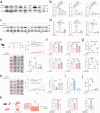Caffeine enhances antitumor T-cell activity by suppressing kynurenine pathway in colorectal cancer
- PMID: 40595642
- PMCID: PMC12216989
- DOI: 10.1038/s41467-025-60958-0
Caffeine enhances antitumor T-cell activity by suppressing kynurenine pathway in colorectal cancer
Abstract
Colorectal cancer (CRC) is a leading global health issue, ranking third in incidence and second in cancer mortality. Immunotherapy, effective mainly in mismatch repair-deficient CRC, may benefit from dietary interventions. This study investigates caffeine's potential to boost programmed death-1 (PD-1) immunotherapy efficacy in CRC, revealing that caffeine significantly reduces tumor growth, extends survival, and enhances CD8+ T cell activity in CRC by suppressing kynurenine pathway. Mechanistically, caffeine decreases kynurenine via the Krüppel-like factor 4 (KLF4)- Collagen type XII alpha 1 (COL12A1)- Mitogen-Activated Protein Kinase (MAPK)-Indoleamine 2,3-dioxygenase 1 (IDO1) axis, mitigating CD8+ T cell exhaustion. Combining caffeine with PD-1 therapy further prolongs survival, highlighting the value of integrating nutritional strategies into cancer treatment to improve outcomes and broaden therapeutic options. Here, we show caffeine can enhance PD-1 immunotherapy in CRC by suppressing kynurenine pathway, suggesting its potential as an adjunctive dietary therapy.
© 2025. The Author(s).
Conflict of interest statement
Competing interests: The authors declare no competing interests.
Figures







References
-
- Bray, F. et al. Global cancer statistics 2022: GLOBOCAN estimates of incidence and mortality worldwide for 36 cancers in 185 countries. CA Cancer J. Clin.74, 229–263 (2024). - PubMed
-
- Kather, J. N., Halama, N. & Jaeger, D. Genomics and emerging biomarkers for immunotherapy of colorectal cancer. Semin Cancer Biol.52, 189–197 (2018). - PubMed
MeSH terms
Substances
Grants and funding
- 82073063/National Natural Science Foundation of China (National Science Foundation of China)
- 82103595/National Natural Science Foundation of China (National Science Foundation of China)
- 81972631,82273039,82472887/National Natural Science Foundation of China (National Science Foundation of China)
- 2022A1515010298,2023A1515010980/Natural Science Foundation of Guangdong Province (Guangdong Natural Science Foundation)
- 2023A1515011789, 2025A1515011911/Natural Science Foundation of Guangdong Province (Guangdong Natural Science Foundation)
LinkOut - more resources
Full Text Sources
Medical
Research Materials
Miscellaneous

